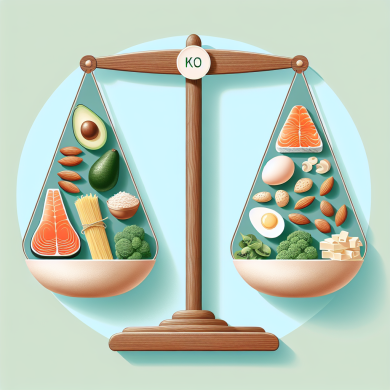Keto Diet and Intermittent Fasting: A Powerful Duo
The Rise of Keto Diet and Intermittent Fasting
In recent years, both the Keto diet and Intermittent Fasting have gained immense popularity as effective approaches for weight management and overall health improvement. While each method has its own merits, combining the two can create a synergistic effect that enhances the benefits of both. This powerful duo has captured the attention of health enthusiasts, nutritionists, and researchers alike, as it offers a promising approach to achieving optimal health.
Understanding the Keto Diet
The ketogenic diet, commonly known as the Keto diet, is a high-fat, low-carbohydrate diet designed to shift the body’s metabolism from relying on glucose as its primary fuel source to utilizing fat. This metabolic state is known as ketosis. By significantly reducing carbohydrate intake and increasing fat consumption, the body starts to break down fats into ketones, which are then used as an alternative energy source.
### Benefits of the Keto Diet
The Keto diet is renowned for its numerous health benefits, including:
1. **Weight Loss**: The primary reason many individuals turn to the Keto diet is its effectiveness in promoting weight loss. By reducing carbohydrate intake and increasing fat consumption, the body is forced to burn stored fat for energy, leading to significant weight loss.
2. **Improved Mental Clarity**: Ketones, the byproducts of fat breakdown, are a potent fuel source for the brain, leading to improved mental clarity and focus.
3. **Stable Blood Sugar Levels**: By minimizing carbohydrate intake, the Keto diet helps stabilize blood sugar levels, making it beneficial for individuals with type 2 diabetes or insulin resistance.
4. **Reduced Inflammation**: The high-fat, low-carb nature of the Keto diet has been shown to reduce inflammation, which is linked to various chronic diseases.
Exploring Intermittent Fasting
Intermittent Fasting (IF) is an eating pattern that cycles between periods of eating and fasting. Unlike traditional diets, IF doesn’t focus on what you eat, but rather on when you eat. The most common methods of IF include the 16/8 method (16 hours of fasting followed by an 8-hour eating window), the 5:2 method (eating normally for five days and restricting calorie intake to 500-600 calories on two non-consecutive days), and the Eat-Stop-Eat method (fasting for 24 hours once or twice a week).
### Benefits of Intermittent Fasting
Intermittent Fasting offers several health benefits, including:
1. **Weight Loss and Fat Loss**: By restricting the eating window, IF naturally reduces calorie intake, promoting weight loss and fat loss over time.
2. **Improved Insulin Sensitivity**: Fasting periods improve insulin sensitivity, allowing the body to use glucose more effectively and reducing the risk of type 2 diabetes.
3. **Cellular Repair and Longevity**: During fasting, the body initiates cellular repair processes and removes waste products, potentially slowing down the aging process and promoting longevity.
4. **Enhanced Brain Function**: Fasting increases the production of brain-derived neurotrophic factor (BDNF), which supports brain health and cognitive function.
The Synergy of Keto Diet and Intermittent Fasting
Combining the Keto diet with Intermittent Fasting can amplify the benefits of both approaches. The synergy between these two methods lies in their complementary effects on metabolism, insulin sensitivity, and fat burning.
### Accelerated Fat Burning
When following the Keto diet, the body is already primed to burn fat for fuel due to ketosis. By adding Intermittent Fasting into the mix, you further enhance fat burning by extending the period during which the body relies on fat stores for energy. This combination accelerates weight loss and helps break through weight loss plateaus.
### Enhanced Ketosis
Intermittent Fasting naturally complements the Keto diet by prolonging the state of ketosis. During fasting periods, glycogen stores are depleted faster, pushing the body to rely on ketones for energy. This not only deepens ketosis but also reduces the time it takes to enter ketosis when starting the Keto diet.
### Improved Insulin Sensitivity
Both the Keto diet and Intermittent Fasting improve insulin sensitivity, making the body more efficient at using glucose. By combining the two, you create a powerful effect that enhances glucose metabolism and reduces the risk of insulin resistance.
### Appetite Control
One of the challenges many face when trying to lose weight is controlling hunger and cravings. The high-fat nature of the Keto diet promotes satiety, while Intermittent Fasting helps regulate hunger hormones like ghrelin, making it easier to adhere to a calorie-restricted diet.
Practical Tips for Combining Keto and Intermittent Fasting
Successfully combining the Keto diet with Intermittent Fasting requires careful planning and execution. Here are some practical tips to help you get started:
### Start Gradually
If you’re new to both the Keto diet and Intermittent Fasting, it’s best to start gradually. Begin by adopting the Keto diet and allowing your body to adjust to ketosis. Once you’re comfortable, introduce Intermittent Fasting, starting with shorter fasting periods and gradually increasing the duration.
### Stay Hydrated
Hydration is essential, especially when combining Keto and IF. Drink plenty of water to stay hydrated and support metabolic processes. Herbal teas and black coffee are also great options during fasting periods.
### Monitor Electrolytes
The Keto diet can lead to electrolyte imbalances, particularly during the initial stages. Ensure you’re getting enough sodium, potassium, and magnesium through your diet or supplements to prevent symptoms like fatigue and muscle cramps.
### Listen to Your Body
Pay close attention to how your body responds to the combination of Keto and IF. Everyone’s experience is unique, so be mindful of any signs of discomfort or fatigue. Adjust your approach as needed to find the right balance for your body.
### Prioritize Nutrient-Dense Foods
Focus on consuming nutrient-dense, whole foods that provide essential vitamins and minerals. This ensures that your body receives the nutrients it needs to function optimally, even during fasting periods.
Potential Challenges and Considerations
While the combination of Keto and Intermittent Fasting offers numerous benefits, it’s important to be aware of potential challenges:
### Adaptation Period
Both the Keto diet and Intermittent Fasting require an adaptation period. Some individuals may experience temporary symptoms like fatigue, irritability, or brain fog as the body adjusts to these changes.
### Individual Variability
Not everyone responds the same way to dietary changes. Some individuals may find it challenging to sustain both the Keto diet and IF, while others thrive on this combination. It’s essential to find an approach that works for your lifestyle and preferences.
### Medical Considerations
Before starting any new diet or fasting regimen, it’s crucial to consult with a healthcare professional, especially if you have underlying health conditions or are taking medications.
Conclusion
The combination of the Keto diet and Intermittent Fasting forms a powerful duo that can significantly enhance weight loss, improve metabolic health, and promote overall well-being. By leveraging the synergistic effects of these two approaches, individuals can experience accelerated fat burning, increased ketosis, improved insulin sensitivity, and better appetite control. However, it’s important to approach this combination mindfully, considering individual needs and potential challenges. With the right strategy and guidance, the Keto diet and Intermittent Fasting can be a transformative journey toward optimal health.















Add comment